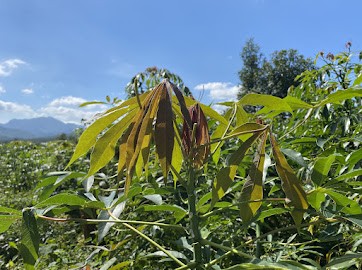(VOVWORLD) - Fried cassava leaves is one of the specialties of the Bahnar ethnic minority people in the Central Highlands province of Gia Lai. The dish, prepared in a very traditional way, is an indispensable part of the Bahnars’ daily diet.
 Cassava leaves can be used to make side dishes. Cassava leaves can be used to make side dishes. |
A: Welcome to VOV 24/7’s Food Delight, We’re A and B. We’re happy to be with you today.
B: Today we’re going to share with you a bittersweet dish from the Bahnar ethnic minority people of the Central Highlands province of Gia Lai. It’s fried cassava leaves.
A: Cassava is the main food crop of Gia Lai’s basalt red lands, because it’s easy to grow and grows all year round. Cassava is usually planted at the end of the dry season and the beginning of the rainy season in April or May, when the temperatures rise and rains start occurring regularly. It’s harvested 8-10 months after planting.
B: Although cassava is best known for its edible tuberous root, the Bahnar also make use of its leaves to make side dishes for their daily meals. According to Y Binh, a Bahnar man, only cassava leaves with red or white stems should be picked. The green ones are toxic. And young leaves should be picked because old leaves are bitter and acidic and not sticky enough after being pounded.
A: There’s one interesting thing that makes the fried cassava leaves of the Bahnar different from that of other ethnic groups, according to Y Binh.
“We don’t wash the leaves before cooking them. That retains their resin, which is good for your health. Washing also reduces the flavor of the leaves. Since the leaves grow at the top of the plant, they are already clean from the rain.”
B: The leaves are ground and squeezed by hand to get all the water out. This reduces the bitterness and speeds up the frying, Binh said.
“Cassava leaves are very bitter, which makes them hard to eat. But you can reduce the bitterness by squeezing out the water after about 10 minutes of pounding. Other ingredients, like crab or bitter aubergine, are often added to make the dish more flavorful. We alter the additional ingredients from time to time just for variety.”
A: It is essential to fry the leaves thoroughly and stir until their texture becomes smooth in order to bring out the crispiness and fresh aroma. Binh gave us this warning before digging in, “You should try a little first to see whether you have any reaction, and then continue. Eating too much improperly prepared cassava leaves can lead to poisoning. Once, in my village, a cow got sick and died when people overfed it with raw cassava leaves.”
B: So there you go…a simple but special dish made from cassava leaves. The dish can be served with white rice and enjoyed as a main dish.
A: Once you taste fried cassava leaves, you may find it hard to resist a second helping. For more recipes, please visit vovworld.vn/Food-delight, where several recipes are already waiting for you. Join us again next week for more ideas to diversify your menu. Goodbye for now!